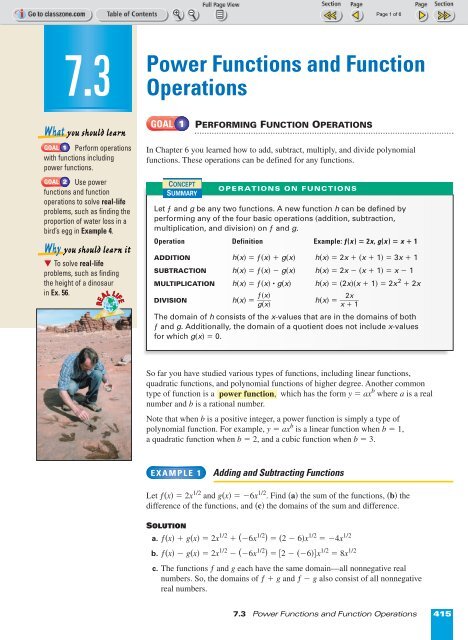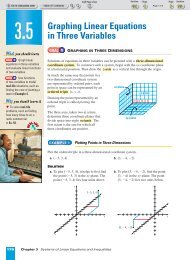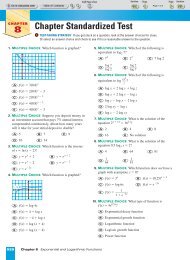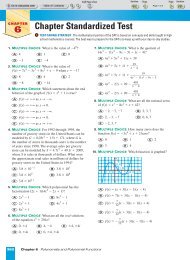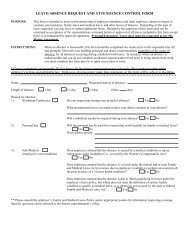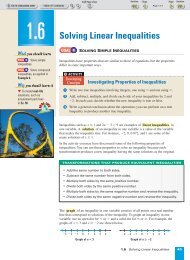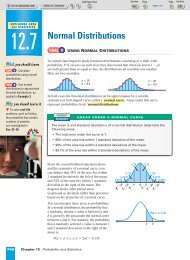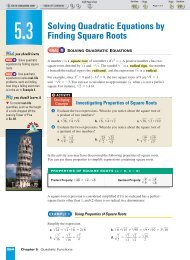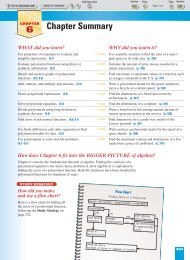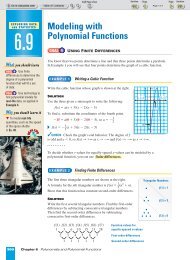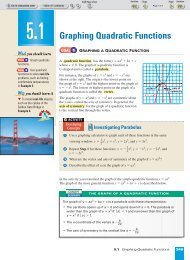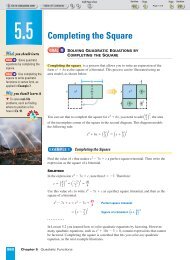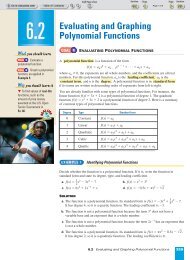Alg. 2 Chapter 7.3 - Beau Chene High School Home Page
Alg. 2 Chapter 7.3 - Beau Chene High School Home Page
Alg. 2 Chapter 7.3 - Beau Chene High School Home Page
You also want an ePaper? Increase the reach of your titles
YUMPU automatically turns print PDFs into web optimized ePapers that Google loves.
<strong>7.3</strong><br />
Power Functions and Function<br />
Operations<br />
What you should learn<br />
GOAL 1 Perform operations<br />
with functions including<br />
power functions.<br />
GOAL 2 Use power<br />
functions and function<br />
operations to solve real-life<br />
problems, such as finding the<br />
proportion of water loss in a<br />
bird’s egg in Example 4.<br />
Why you should learn it<br />
To solve real-life<br />
problems, such as finding<br />
the height of a dinosaur<br />
in Ex. 56.<br />
REAL<br />
LIFE<br />
GOAL 1<br />
PERFORMING FUNCTION OPERATIONS<br />
In <strong>Chapter</strong> 6 you learned how to add, subtract, multiply, and divide polynomial<br />
functions. These operations can be defined for any functions.<br />
CONCEPT<br />
SUMMARY<br />
OPERATIONS ON FUNCTIONS<br />
Let ƒ and g be any two functions. A new function h can be defined by<br />
performing any of the four basic operations (addition, subtraction,<br />
multiplication, and division) on ƒ and g.<br />
Operation Definition Example: ƒ(x ) = 2x, g(x ) = x + 1<br />
ADDITION h(x) = ƒ(x) + g(x) h(x) = 2x + (x + 1) = 3x + 1<br />
SUBTRACTION h(x) = ƒ(x) º g(x) h(x) = 2x º (x + 1) = x º 1<br />
MULTIPLICATION h(x) = ƒ(x) • g(x) h(x) = (2x)(x + 1) = 2x 2 + 2x<br />
ƒ( x)<br />
2x<br />
DIVISION h(x) = h(x) = <br />
g ( x)<br />
x + 1<br />
The domain of h consists of the x-values that are in the domains of both<br />
ƒ and g. Additionally, the domain of a quotient does not include x-values<br />
for which g(x) = 0.<br />
So far you have studied various types of functions, including linear functions,<br />
quadratic functions, and polynomial functions of higher degree. Another common<br />
type of function is a power function, which has the form y = ax b where a is a real<br />
number and b is a rational number.<br />
Note that when b is a positive integer, a power function is simply a type of<br />
polynomial function. For example, y = ax b is a linear function when b = 1,<br />
a quadratic function when b = 2, and a cubic function when b = 3.<br />
EXAMPLE 1<br />
Adding and Subtracting Functions<br />
Let ƒ(x) = 2x 1/2 and g(x) = º6x 1/2 . Find (a) the sum of the functions, (b) the<br />
difference of the functions, and (c) the domains of the sum and difference.<br />
SOLUTION<br />
a. ƒ(x) + g(x) = 2x 1/2 + (º6x 1/2 ) = (2 º 6)x 1/2 = º4x 1/2<br />
b. ƒ(x) º g(x) = 2x 1/2 º (º6x 1/2 ) = 2 º (º6)x 1/2 = 8x 1/2<br />
c. The functions ƒ and g each have the same domain—all nonnegative real<br />
numbers. So, the domains of ƒ + g and ƒ º g also consist of all nonnegative<br />
real numbers.<br />
<strong>7.3</strong> Power Functions and Function Operations 415
EXAMPLE 2<br />
Multiplying and Dividing Functions<br />
STUDENT HELP<br />
Look Back<br />
For help with function<br />
operations, see p. 338.<br />
Let ƒ(x) = 3x and g(x) = x 1/4 . Find (a) the product of the functions, (b) the quotient<br />
of the functions, and (c) the domains of the product and quotient.<br />
SOLUTION<br />
a. ƒ(x) • g(x) = (3x)(x 1/4 ) = 3x (1 + 1/4) = 3x 5/4<br />
b. ƒ ( x)<br />
3x<br />
= = 3x<br />
g(<br />
x)<br />
(1 º 1/4) = 3x 3/4<br />
x<br />
1/4<br />
c. The domain of ƒ consists of all real numbers and the domain of g consists<br />
of all nonnegative real numbers. So, the domain of ƒ • g consists of all<br />
ƒ<br />
nonnegative real numbers. Because g(0) = 0, the domain of g is restricted<br />
to all positive real numbers.<br />
. . . . . . . . . .<br />
A fifth operation that can be performed with two functions is composition.<br />
COMPOSITION OF TWO FUNCTIONS<br />
The composition of the function ƒ<br />
with the function g is:<br />
h(x) = ƒ(g(x))<br />
The domain of h is the set of all<br />
x-values such that x is in the domain<br />
of g and g(x) is in the domain of ƒ.<br />
Input<br />
domain of g<br />
x<br />
Output<br />
range of g<br />
g(x)<br />
domain of ƒ<br />
Input<br />
ƒ(g(x))<br />
range of ƒ<br />
Output<br />
As with subtraction and division of functions, you need to pay attention to the order<br />
of functions when they are composed. In general, ƒ(g(x)) is not equal to g(ƒ(x)).<br />
EXAMPLE 3<br />
Finding the Composition of Functions<br />
Let ƒ(x) = 3x º1 and g(x) = 2x º 1. Find the following.<br />
a. ƒ(g(x)) b. g(ƒ(x)) c. ƒ(ƒ(x)) d. the domain of each composition<br />
STUDENT HELP<br />
Study Tip<br />
When you are writing the<br />
composition of ƒ with g,<br />
you may want to first<br />
rewrite ƒ(x) = 3x º1 as<br />
ƒ( ) = 3( ) º1<br />
and then substitute<br />
g(x) = 2x º 1 everywhere<br />
there is a box.<br />
SOLUTION<br />
a. ƒ(g(x)) = ƒ(2x º 1) = 3(2x º 1) º1 3<br />
= <br />
2x º1<br />
b. g(ƒ(x)) = g(3x º1 ) = 2(3x º1 ) º 1 = 6x º1 º 1 = 6 x º 1<br />
c. ƒ(ƒ(x)) = ƒ(3x º1 ) = 3(3x º1 ) º1 = 3(3 º1 x) = 3 0 x = x<br />
d. The domain of ƒ(g(x)) consists of all real numbers except x = 1 2 because<br />
g 1 2 =0 is not in the domain of ƒ. The domains of g(ƒ(x)) and ƒ(ƒ(x)) consist<br />
of all real numbers except x = 0, because 0 is not in the domain of ƒ. Note that<br />
ƒ(ƒ(x)) simplifies to x, but that result is not what determines the domain.<br />
416 <strong>Chapter</strong> 7 Powers, Roots, and Radicals
FOCUS ON<br />
APPLICATIONS<br />
GOAL 2<br />
USING FUNCTION OPERATIONS IN REAL LIFE<br />
EXAMPLE 4<br />
Using Function Operations<br />
BIOLOGY The<br />
largest bird egg<br />
is an ostrich’s egg, which<br />
has a mass of about<br />
1.65 kilograms. For<br />
comparison, an average<br />
chicken egg has a mass<br />
of only 56.7 grams.<br />
REAL<br />
LIFE<br />
BIOLOGY CONNECTION You are doing a science project and have found research<br />
indicating that the incubation time I (in days) of a bird’s egg can be modeled by<br />
I(m) = 12m 0.217 where m is the egg’s mass (in grams). You have also found that<br />
during incubation the egg’s rate of water loss R (in grams per day) can be modeled by<br />
R(m) =0.015m 0.742 .<br />
You conjecture that the proportion of water loss during incubation is about the same<br />
for any size egg. Show how you can use the two power function models to verify<br />
your conjecture. Source: Biology by Numbers<br />
SOLUTION<br />
VERBAL<br />
MODEL<br />
Proportion<br />
of water<br />
loss<br />
Total water loss<br />
= =<br />
Egg’s mass<br />
Daily water loss • Number of days<br />
<br />
Egg’s mass<br />
LABELS<br />
Daily water loss =Number R(m) of days =Egg’s I(m) mass = m<br />
ALGEBRAIC<br />
MODEL<br />
R(m) • I(m)<br />
<br />
m<br />
=<br />
=<br />
(0.015m 0.742 )(12m 0.217 )<br />
<br />
m<br />
0.18m 0.959<br />
m<br />
= 0.18m º0.041<br />
Because m º0.041 is approximately m 0 , the proportion of water loss can be treated as<br />
0.18m 0 = (0.18)(1) = 0.18. So, the proportion of water loss is about 18% for any<br />
size bird’s egg, and your conjecture is correct.<br />
REAL<br />
LIFE<br />
EXAMPLE 5<br />
Using Composition of Functions<br />
Business<br />
A clothing store advertises that it is having a 25% off sale. For one day only, the store<br />
advertises an additional savings of 10%.<br />
a. Use composition of functions to find the total percent discount.<br />
b. What would be the sale price of a $40 sweater?<br />
STUDENT HELP<br />
Skills Review<br />
For help with calculating<br />
percents, see p. 907.<br />
SOLUTION<br />
a. Let x represent the price. The sale price for a 25% discount can be represented by<br />
the function ƒ(x) = x º 0.25x = 0.75x. The reduced sale price for an additional<br />
10% discount can be represented by the function g(x) = x º 0.10x = 0.90x.<br />
g(ƒ(x)) = g(0.75x) = 0.90(0.75x) = 0.675x<br />
The total percent discount is 100% º 67.5% = 32.5%.<br />
b. Let x = 40. Then g(ƒ(x)) = g(ƒ(40)) = 0.675(40) = 27.<br />
The sale price of the sweater is $27.<br />
<strong>7.3</strong> Power Functions and Function Operations 417
GUIDED PRACTICE<br />
Vocabulary Check ✓<br />
Concept Check ✓<br />
1. Complete this statement: The function y = ax b is a(n) ? function where a is<br />
a(n) ? number and b is a(n) ? number.<br />
2. LOGICAL REASONING Tell whether the sum of two power functions is<br />
sometimes, always, or never a power function.<br />
ERROR ANALYSIS Let ƒ(x) = x 2 + 2 and g(x) = 3x. What is wrong with the<br />
composition shown? Explain.<br />
Skill Check ✓<br />
3. 4.<br />
f (g(x)) = f (x 2 + 2)<br />
f (g(x)) = f (3x)<br />
= 3(x 2 + 2) = 3x 2 + 2<br />
= 3x 2 + 6<br />
Let ƒ(x) = 4x and g(x) = x º 1. Perform the indicated operation and state<br />
the domain.<br />
5. ƒ(x) + g(x) 6. ƒ(x) º g(x) 7. ƒ(x) • g(x)<br />
8. ƒ ( x)<br />
9. ƒ(g(x)) 10. g(ƒ(x))<br />
g(<br />
x)<br />
11. SALES BONUS You are a sales representative for a clothing manufacturer.<br />
You are paid an annual salary plus a bonus of 2% of your sales over $200,000.<br />
Consider two functions: ƒ(x) = x º 200,000 and g(x) = 0.02x. If x > $200,000,<br />
which composition, ƒ(g(x)) or g(ƒ(x)), represents your bonus? Explain.<br />
PRACTICE AND APPLICATIONS<br />
STUDENT HELP<br />
Extra Practice<br />
to help you master<br />
skills is on p. 949.<br />
ADDING AND SUBTRACTING FUNCTIONS Let ƒ(x) = x 2 º 5x + 8 and<br />
g(x) = x 2 º 4. Perform the indicated operation and state the domain.<br />
12. ƒ(x) + g(x) 13. g(x) + ƒ(x) 14. ƒ(x) + ƒ(x) 15. g(x) + g(x)<br />
16. ƒ(x) º g(x) 17. g(x) º ƒ(x) 18. ƒ(x) º ƒ(x) 19. g(x) º g(x)<br />
MULTIPLYING AND DIVIDING FUNCTIONS Let ƒ(x) = 2x 2/3 and g(x) = 3x 1/2 .<br />
Perform the indicated operation and state the domain.<br />
STUDENT HELP<br />
HOMEWORK HELP<br />
Example 1: Exs. 12–19,<br />
32–51<br />
Example 2: Exs. 20–27,<br />
32–51<br />
Example 3: Exs. 28–51<br />
Example 4: Exs. 52, 53<br />
Example 5: Exs. 54–56<br />
20. ƒ(x) • g(x) 21. g(x) • ƒ(x) 22. ƒ(x) • ƒ(x) 23. g(x) • g(x)<br />
24. ƒ ( x)<br />
g(<br />
x)<br />
<br />
25. <br />
26. ƒ ( x)<br />
g(<br />
x)<br />
<br />
27. <br />
g(<br />
x)<br />
ƒ ( x)<br />
ƒ(<br />
x)<br />
g ( x)<br />
COMPOSITION OF FUNCTIONS Let ƒ(x) = 4x º5 and g(x) = x 3/4 . Perform the<br />
indicated operation and state the domain.<br />
28. ƒ(g(x)) 29. g(ƒ(x)) 30. ƒ(ƒ(x)) 31. g(g(x))<br />
FUNCTION OPERATIONS Let ƒ(x) = 10x and g(x) = x + 4. Perform the<br />
indicated operation and state the domain.<br />
ƒ(<br />
x)<br />
32. ƒ(x) + g(x) 33. ƒ(x) º g(x) 34. ƒ(x) • g(x) 35. <br />
g ( x)<br />
36. ƒ(g(x)) 37. g(ƒ(x)) 38. ƒ(ƒ(x)) 39. g(g(x))<br />
418 <strong>Chapter</strong> 7 Powers, Roots, and Radicals
FUNCTION OPERATIONS Perform the indicated operation and state<br />
the domain.<br />
40. ƒ + g; ƒ(x) = x + 3, g(x) = 5x 41. ƒ + g; ƒ(x) = 3x 1/2 , g(x) = º2x 1/2<br />
42. ƒ º g; ƒ(x) = ºx 2/3 , g(x) = x 2/3 43. ƒ º g; ƒ(x) = x 2 º 3, g(x) = x + 5<br />
44. ƒ • g; ƒ(x) = 7x 2/5 , g(x) = º2x 3 45. ƒ • g; ƒ(x) = x º 4, g(x) = 4x 2<br />
46. ƒ g ; ƒ(x) = 9xº1 , g(x) = x 1/4 47. ƒ g ; ƒ(x) = x2 º 5x, g(x) = x<br />
PALEONTOLOGIST<br />
A paleontologist is a<br />
scientist who studies fossils<br />
of dinosaurs and other<br />
prehistoric life forms. Most<br />
paleontologists work as<br />
college professors.<br />
CAREER LINK<br />
www.mcdougallittell.com<br />
INTERNET<br />
STUDENT HELP<br />
HOMEWORK HELP<br />
Visit our Web site<br />
www.mcdougallittell.com<br />
for help with problem<br />
solving in Ex. 53.<br />
REAL<br />
INTERNET<br />
LIFE<br />
FOCUS ON<br />
CAREERS<br />
48. ƒ(g(x)); ƒ(x) = 6x º1 , g(x) = 5x º 2 49. g(ƒ(x)); ƒ(x) = x 2 º 3, g(x) = x 2 + 1<br />
50. ƒ(ƒ(x)); ƒ(x) = 2x 1/5 51. g(g(x)); g(x) = 9x º 2<br />
52. HEART RATE For a mammal, the heart rate r (in beats per minute) and<br />
the life span s (in minutes) are related to body mass m (in kilograms) by these<br />
formulas:<br />
r(m) =241m º0.25 s(m)=(6 ª 10 6 )m 0.2<br />
Find the relationship between body mass and average number of heartbeats in a<br />
lifetime by calculating r(m)•s(m). Explain the results.<br />
Source: Physiology by Numbers<br />
53. BREATHING RATE For a mammal, the volume b (in milliliters) of air<br />
breathed in and the volume d (in milliliters) of the dead space (the portion of<br />
the lungs not filled with air) are related to body weight w (in grams) by these<br />
formulas:<br />
b(w) = 0.007w d(w) = 0.002w<br />
The relationship between breathing rate r (in breaths per minute) and body<br />
weight is:<br />
0. 734<br />
1.1w<br />
r(w) = <br />
b( w)<br />
º d(<br />
w)<br />
Simplify r(w) and calculate the breathing rate for body weights of 6.5 grams,<br />
12,300 grams, and 70,000 grams. Source: Respiration<br />
COAT SALE In Exercises 54 and 55, use the following information.<br />
A clothing store is having a sale in which you can take $50 off the cost of any coat in<br />
the store. The store also offers 10% off your entire purchase if you open a charge<br />
account. You decide to open a charge account and buy a coat.<br />
54. Use composition of functions to find the sale price of a $175 coat when $50 is<br />
subtracted before the 10% discount is applied.<br />
55. CRITICAL THINKING Why doesn’t the store apply the 10% discount before<br />
subtracting $50?<br />
56. PALEONTOLOGY The height at the hip h (in centimeters) of an<br />
ornithomimid, a type of dinosaur, can be modeled by<br />
h(l) =3.49l 1.02<br />
where l is the length (in centimeters) of the dinosaur’s instep. The length of the<br />
instep can be modeled by<br />
l( f) = 1.5f<br />
where f is the footprint length (in centimeters). Use composition of functions to<br />
find the relationship between height and footprint length. Then find the height of<br />
an ornithomimid with a footprint length of 30 centimeters. Source: Dinosaur Tracks<br />
<strong>7.3</strong> Power Functions and Function Operations 419
Test<br />
Preparation<br />
★ Challenge<br />
EXTRA CHALLENGE<br />
www.mcdougallittell.com<br />
57. Writing Explain how to perform the function operations ƒ(x) + g(x),<br />
ƒ(x) º g(x), ƒ(x) • g(x), ƒ ( x)<br />
, and ƒ(g(x)) for any two functions ƒ and g.<br />
g(<br />
x)<br />
QUANTITATIVE COMPARISON In Exercise 58–61, choose the statement that is<br />
true about the given quantities.<br />
58.<br />
59.<br />
60.<br />
61.<br />
¡ A The quantity in column A is greater.<br />
¡ B The quantity in column B is greater.<br />
¡ C The two quantities are equal.<br />
¡ D The relationship cannot be determined from the given information.<br />
ƒ(g(4)); ƒ(x) = 6x, g(x) = 3x 2 ƒ(g(2)); ƒ(x) = x 2/3 , g(x) = º2x<br />
g(ƒ(º1)); ƒ(x) = 5x º2 , g(x) = x g(ƒ(0)); ƒ(x) = 2x + 5, g(x) = x 2<br />
ƒ(ƒ(3)); ƒ(x) = 3x º 7 ƒ(ƒ(º2)); ƒ(x) = 10x 3<br />
g(g(5)); g(x) = 16x º1/4 g(g(7)); g(x) = x 2 + 8<br />
FUNCTION COMPOSITION Find functions ƒ and g such that ƒ(g(x)) = h(x).<br />
62. h(x) = (6x º 5) 3 63. h(x) = 3 x+ 2<br />
4 x<br />
64. h(x) = 65. h(x) = 3x 2 + 7<br />
2<br />
Column A Column B<br />
66. h(x) = |2x + 9| 67. h(x) = 21x<br />
MIXED REVIEW<br />
REWRITING EQUATIONS Solve the equation for y. (Review 1.4 for 7.4)<br />
68. y º 3x = 10 69. 2x + 3y = º8 70. x = º2y + 6<br />
71. xy + 2 = 7 72. 1 2 x º 2 y = 1 73. ax + by = c<br />
3<br />
GRAPHING FUNCTIONS Graph the function. (Review 2.1 for 7.4)<br />
74. y = x º 2 75. y = 4x º 3 76. y = 5x º 2 3 <br />
77. y = º2x º 4 78. y = º 1 x + 7 79. y = º8<br />
2<br />
SOLVING EQUATIONS Find the real-number solutions of the equation.<br />
(Review 6.4)<br />
80. 3x 3 º 2x 2 = 0 81. 2x 3 º 6x 2 + x = 3<br />
82. 5x 4 + 19x 2 º 4 = 0 83. x 4 + 6x 3 + 8x + 48 = 0<br />
5 2<br />
84. CRYPTOGRAPHY Use the inverse of A = and the code on page 225<br />
2 1<br />
to decode the message. (Review 4.4)<br />
45, 21, 84, 35, 92, 37, 142, 61<br />
62, 25, 118, 49, 103, 44, 95, 38<br />
420 <strong>Chapter</strong> 7 Powers, Roots, and Radicals


